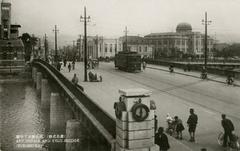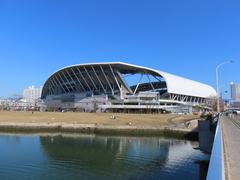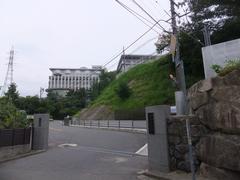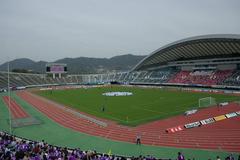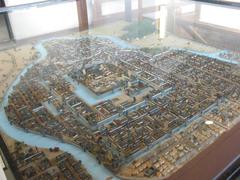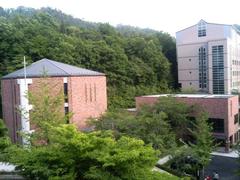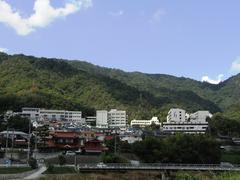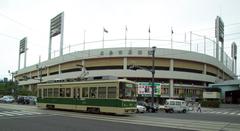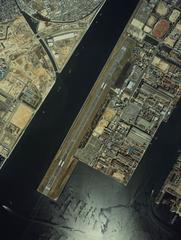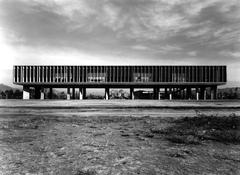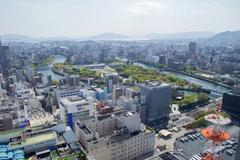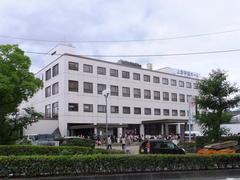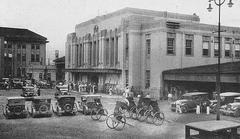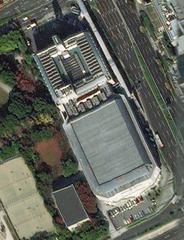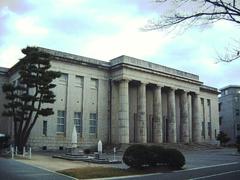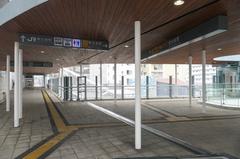
Hakushima Station Hiroshima: Visiting Hours, Tickets, and Travel Guide
Date: 04/07/2025
Introduction
Hakushima Station, located in Naka-ku, Hiroshima, is a central transit hub that seamlessly connects visitors to the city’s historical legacy and vibrant urban culture. Serving both the Hiroden Hakushima Line and Astram Line, Hakushima Station is a testament to Hiroshima’s enduring spirit, urban innovation, and commitment to accessibility. This comprehensive guide details the station’s visiting hours, ticket options, architectural highlights, facilities, nearby attractions, travel tips, and practical information for tourists and daily commuters.
Historical Significance and Modern Development
Early History
The area around Hakushima Station has been crucial to Hiroshima’s transit evolution since the early 20th century. The Hiroshima Electric Railway was founded in 1910, and streetcar operations began in 1912, marking the city’s entry into modern transportation (Japan Experience). By 1931, an extensive network connected the city to outlying regions, including Miyajima-guchi.
Hakushima Station serves as the terminal on the Hiroden Hakushima Line, offering a simple layout with a single side platform and direct city access (Wikipedia: Hakushima Station (Hiroden)).
Wartime and Postwar Period
Hiroshima’s tram system played a crucial role during World War II, sustaining operations amidst significant hardship. Following the atomic bombing in 1945, tram services resumed within days, symbolizing hope and recovery (Japan Experience; Hiroshima Prefectural Office). The postwar era saw extensive reconstruction, with the Hakushima Line becoming a symbol of resilience.
Modernization: Astram Line and Shin-Hakushima Station
The Astram Line, launched in 1994, is a rapid transit system designed to address urban growth and ease congestion (UrbanRail.Net). The opening of Shin-Hakushima Station in 2015 further enhanced connectivity, bridging the Astram Line with the JR Sanyo Main Line. The station’s award-winning design, inspired by the Hiroshima Peace Memorial Park, underscores the city’s dedication to peace and sustainability (World-Architects; Wikipedia: Shin-Hakushima Station).
Visiting Hakushima Station: Practical Information
Operating Hours and Ticketing
- Hakushima Station (Astram Line): Open daily from 6:00 AM to midnight.
- Hiroden Hakushima Line: Streetcar services run from around 6:00 AM to 11:00 PM.
- Shin-Hakushima Station (JR/Astram): Open from about 5:00 AM to midnight.
Tickets: Purchase single-ride tickets, commuter passes, or 1-Day Tickets (unlimited Astram Line rides: 900 JPY adults/450 JPY children) at vending machines or with IC cards like PASPY and ICOCA. Updated fares and schedules are available on official sites (Hiroshima Electric Railway, JR West).
Accessibility
Both Hakushima and Shin-Hakushima Stations are designed for universal access. Facilities include elevators, ramps, tactile paving, and wide gates for wheelchairs and strollers. Accessible restrooms are available, and station staff are present during operating hours to assist travelers (TransportWiki).
Station Facilities
- Restrooms: Clean, accessible facilities.
- Lockers: Coin-operated storage for luggage.
- Waiting Areas: Sheltered benches and seating.
- Information Displays: Multilingual digital signs for schedules and tourist info.
- Customer Service: Staffed counters for directions and support.
- Vending Machines: Snacks and drinks available.
Safety and Security
Security cameras, emergency call buttons, and clearly marked evacuation routes ensure a safe environment. The station’s open design helps prevent congestion.
Architectural Highlights
Shin-Hakushima Station, designed by Coelacanth and Associates, features a distinctive shell-like vaulted roof with circular openings for natural light. Its structure uses ribbed steel plates and glass apertures, creating a bright, serene space for travelers. The green roof, planted with vines, improves the microclimate and reflects Hiroshima’s sustainability goals (World-Architects).
Awarded the International Architecture Awards in 2019, the station blends functionality, accessibility, and aesthetics, embodying Hiroshima’s vision for urban livability.
Transportation Connections
- Astram Line: Connects central Hiroshima with northern and western suburbs. Trains run at 2–5 minute intervals during peak hours (TransportWiki).
- JR Sanyo Main Line: Transfer at Shin-Hakushima for rapid access to Hiroshima Station (Shinkansen, local lines, long-distance buses).
- Bus Networks: Hiroden Bus, Hiroshima Bus, Geiyo Bus, and others serve stops near the station, linking to neighborhoods and key destinations.
- Hiroden Streetcar: Transfer at nearby Astram Line stations (Hondori, Kencho-mae) for quick access to historic sites.
- Taxi/Bicycle: Taxi stands and bicycle parking available for further convenience.
Nearby Attractions: What to See and Do
Hakushima Station’s central location makes it an ideal starting point for exploring Hiroshima’s top attractions:
- Hiroshima Castle (“Carp Castle”): 10–15 min walk or Astram Line ride. Open 9:00 AM–6:00 PM (admission: 370 JPY). Renowned for its museum and cherry blossoms (TravelSetu; Nomadic Matt).
- Shukkeien Garden: 5 min walk. Historic landscape garden, open 9:00 AM–6:00 PM (admission: 260 JPY) (Sotetsu Hotels).
- Hiroshima Prefectural Art Museum: Next to Shukkeien, open 9:00 AM–5:00 PM (closed Mondays) (Japan Welcomes You).
- Peace Memorial Park & Museum: 20 min tram ride or walk. Park open daily, museum 8:30 AM–6:00 PM (admission: 200 JPY) (Explore Hiroshima; Travel & Leisure Asia).
- Okonomimura: Food complex with Hiroshima-style okonomiyaki. Open 11:00 AM–10:00 PM (Explore Hiroshima).
- Hondori Shopping Street: 15 min walk; shops, cafes, and nightlife (Explore Hiroshima).
- Hiroshima Museum of Art: Near Hiroshima Castle; open 9:30 AM–5:00 PM (Japan Welcomes You).
- Mazda Museum: Guided tours by reservation (Japan Welcomes You).
- Hiroshima Toshogu Shrine: 15 min northeast; open 9:00 AM–5:00 PM (Sotetsu Hotels).
- Mitakidera Temple: Accessible by local train; beautiful in cherry blossom and autumn seasons (TravelSetu).
- Saijo Sake Brewery District: 30 min by train; historic sake breweries and annual festival (Nomadic Matt).
- Miyajima Island (Itsukushima): UNESCO site; 60–90 min via train and ferry (Japan Welcomes You; Nomadic Matt).
Cultural Context
Hakushima is a primarily residential and educational district, shaped by postwar reconstruction and modern urban planning. Its proximity to historical sites, parks, and cultural venues makes it a convenient base for exploring Hiroshima’s legacy of peace, resilience, and innovation (Travel & Leisure Asia).
The area is known for its hospitality, culinary traditions, and seasonal festivals, such as the Flower Festival in May and Peace Memorial Ceremony in August (Nomadic Matt). Local shopping streets and izakayas offer a taste of Hiroshima’s evolving culture.
Travel Tips and Photo Opportunities
- Best Time to Visit: Spring (cherry blossoms) and autumn (foliage).
- Photography: Hiroshima Castle, Shukkeien Garden, Peace Memorial Park at sunset.
- Guided Tours: Enhance your visit with local historical and cultural tours.
- Ticketing: Hiroshima Tourist Pass offers unlimited rides on public transport (1,000–2,000 JPY; 24–72 hours).
- Luggage Storage: Use coin lockers at the station.
- Accessibility: Wide gates, elevators, and ramps support travelers with disabilities.
Frequently Asked Questions (FAQ)
Q: What are Hakushima Station’s hours?
A: The Astram Line operates from 6:00 AM to midnight; streetcars from 6:00 AM to 11:00 PM.
Q: How do I buy tickets?
A: Use vending machines or IC cards at the station. Hiroshima Tourist Passes are also available.
Q: Is Hakushima Station accessible?
A: Yes, it features elevators, ramps, tactile paving, and accessible restrooms.
Q: Are there guided tours?
A: Yes, local operators offer tours that often depart near Hakushima Station.
Q: How do I transfer to JR lines?
A: Use Shin-Hakushima Station, one Astram Line stop north, for JR Sanyo Main Line access.
Conclusion
Hakushima Station is more than a transportation hub—it’s a gateway to Hiroshima’s historical, cultural, and architectural highlights. Its strategic location, accessible facilities, and modern design make it ideal for both tourists and locals. Use the tips and resources provided to plan your journey, explore the area’s attractions, and immerse yourself in the spirit of Hiroshima.
Download the Audiala app for real-time transit updates, travel guides, and personalized itineraries. For more in-depth guides and the latest travel tips, follow us on social media and check related posts.
References & External Links
- Japan Experience
- World-Architects
- TransportWiki
- TravelSetu
- Explore Hiroshima
- Nomadic Matt
- UrbanRail.Net
- Hiroshima Electric Railway
- JR West
- Sotetsu Hotels
- Japan Welcomes You
- Travel & Leisure Asia


